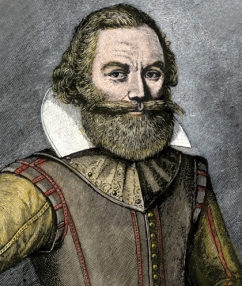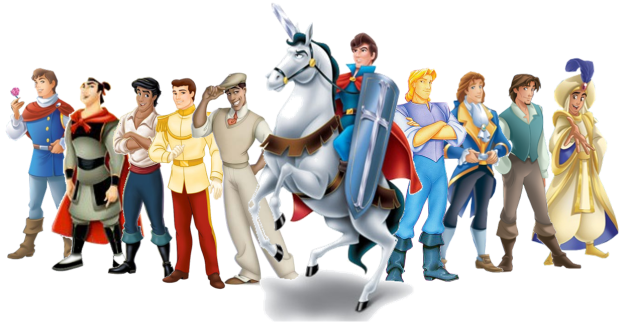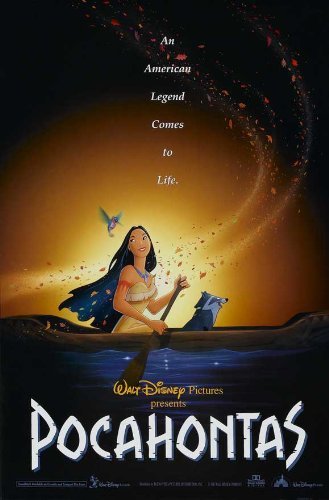The tale of Pocahontas and John Smith has been passed through American lore for generations. Numerous films, books, plays, oral histories, and songs have been produced in the name of Pocahontas to tell the story. The most famous of these, Walt Disney’s Pocahontas, was released in 1995. The animated film did well in the box office, but was criticized by many for its historical inaccuracies and problematic representations of Native American culture. As probably one of the last people in America to have never seen the film before, I thought it would be interesting to take what we learned about the settlement of Jamestown and the Pocahontas story and compare it to the events depicted in the film, all with fresh eyes. After watching the movie, it was obvious why so many were critical of it upon its release. The creators sacrificed historical accuracy for a cute love story about people from different races. People often look at films that portray historical events and take them as the actual histories, which can be dangerous if the movie is inaccurate. When comparing the Disney film to the actual historical account, given by historian Alan Taylor in his book American Colonies, these potentially harmful changes to the story are revealed.
In the movie, John Smith and his fellow Englishmen sail to the New World under the command of Governor Ratcliffe, a greedy man obsessed with finding gold. They land on the coast of Virginia, establishing Jamestown. With orders to shoot any Indians in sight, Smith meets free-spirited Pocahontas, the daughter of Chief Powhatan, and an instant bond is formed. Pocahontas gets Smith to appreciate nature and the two frolic through the forest, even though they knew their friendship would be frowned upon by their respective races who had begun to clash. After sharing a kiss, Pocahontas’ jealous future husband (and celebrated warrior) Kocoum attacks Smith and is shot. The Natives take away Smith and plan to execute him. Hearing the news, Governor Ratcliffe decides to attack the Indians while the execution is taking place in order to take their gold (which they do not actually possess). Right as Powhatan is about to strike down Smith, Pocahontas throws herself over him, saving his life. Both sides come to the realization that they should not fight, except for Governor Ratcliffe, who tries to shoot Powhatan but winds up shooting Smith instead. Wounded, Smith is sent back to England, but knows he and Pocahontas will share a bond forever.

Some of the most obvious inaccuracies in the movie deal with the makeup of the characters. In the film, both Pocahontas and John Smith are depicted as young adults. The movie version of Smith (pictured above) is an able man (he dove into the ocean at the beginning of the film to save one of his shipmates) with a chiseled jawline and flowing blonde locks. Quite frankly, he’s sexy. His character looks extremely similar to other Disney princes/male hero characters created in this era (and upon further review, he looks almost unmistakably similar to Shrek 2’s depiction of Prince Charming), so Disney clearly had an idea about what a good and powerful man looked like. In reality, Smith (pictured ) below was pretty ugly. The next potential inaccuracy is how the planned execution of John Smith was depicted. The movie shows Powhatan raising a club above his head ready to strike the tied-up Smith before Pocahontas enters the picture and throws her head over Smiths’, preventing the execution. This lines up with the description of the event Smith would give years later (The Pocahontas Myth). However, modern historians, including Taylor, disagree with some of the aspects of this story. Taylor clarifies that after Smith was captured, Powhatan decided to stage a mock execution to claim Smith as a subordinate chief. With the language and customs barrier, Smith thought he was actually getting executed (Taylor 132). It is also unknown whether or not Pocahontas actually threw herself onto Smith or if she just stopped the execution without the dramatic twist.

Some of these changes, along with other features of the film, are seen as problematic by today’s standards. Much like other Disney films from the Disney Renaissance era (for reference, this era began in 1989 with the release of The Little Mermaid and is seen as the revival of Disney films’ popularity on the international stage), Pocahontas was made into a story centered around the classic troupe of a girl stuck between the man her family wants and the man she actually wants. Many Disney films from this time period (and from earlier in Disney’s history, such as Cinderella and Snow White) also make it seem like a woman was never truly satisfied until she had a man by her side. Today, Disney has taken a different, more female-empowering route, with films like Frozen portraying strong female lead characters who are capable of greatness without the help of men. Traditionally, Pocahontas has been seen as a feminist figure who revolted against the rule of her powerful father to save something she cared about. However, the film made her out to be a ditzy girl who needed the stability of a man in her life, whether it was the boring Kocoum or the open-minded Smith. While the statement of Pocahontas standing up for Smith and defying her father at the end of the movie was powerful, it was not enough to take away from the previous hour of Pocahontas chasing Smith around.

The film also created controversy over its treatment of Native Americans. The English settlers used the word “savages” and other derogatory words dozens of times throughout the film. People called out the throwing-around of the phrases, which is understandable given it is a children’s film. But I found this to be one of the most accurate parts of the film. The English saw themselves as superior to the Indians because of their religion, technology, and the whiteness of their skin. When Pocahontas and Smith first met in the film, Smith told her they were going to civilize her people, who he referred to as “savages.” Pocahontas was deeply offended by this and almost walked away from the conversation altogether, creating one of the most powerful moments in the film. Even if this exact conversation did not actually happen, it was undoubtedly representative of what Smith and the English believed. Along with film critics and general viewers of the movie, the Powhatan tribe also had a problem with how the story was presented. The tribe, which now unfortunately ceases to exist, put out a statement after the film was released denouncing it’s portrayal of events, saying “The film distorts history beyond recognition” (The Pocahontas Myth). They accuse Smith of fabricating his original story about Pocahontas saving his life, saying he had made similar claims with different girls before and that it was an attempt to justify war against the Powhatan tribe. At the time of the release of the movie, Natives probably saw it as a good opportunity to represent their people, but were clearly disappointed by the result.
The historical inaccuracies are disappointing, but not surprising, given that this is a film. At the end of the day, the movie-makers are more concerned with getting butts in the seats and money in their pockets than making a perfectly accurate film. A central love story was almost a necessity in these 1990s Disney films, so the addition of one to Pocahontas should have been expected. Going with John Smith’s account of the event (where Pocahontas throws her body over Smith’s) creates a more dramatic ending than just Pocahontas saying “no, stop.” In a vacuum, making a film with these historical inaccuracies for the sake of telling a good story is not that significant. But it is unfortunate that because of the film, this is how people interpret how the events actually occurred. Given the world we live in today, if this movie was redone, it would probably follow the actual events more closely. Whether it would be a hit movie is up for debate. I think it would be, given its award-winning soundtrack and stunning visual components, but taking anything more out of the film than that is a mistake.
Works Cited
Legends of America. “Captain John Smith – Settling the First Colony,” by Kathy Weiser. Captain John Smith – Settling the First Colony, Legends of America, www.legendsofamerica.com/ah-johnsmith/. Accessed 3 May 2018.
My Interesting Facts. “10 Interesting John Smith Facts.” My Interesting Facts, My Interesting Facts, http://www.myinterestingfacts.com/john-smith-facts/. Accessed 3 May 2018.
The Odyssey Online. August 14, 2016. “The Definitive Ranking Of The Official Disney Princes,” by Marissa Holliday. The Odyssey Online, Odyssey Media Group, www.theodysseyonline.com/definitive-ranking-official-disney-princes. Accessed 3 May 2018.
“The Pocahontas Myth.” Rankous Indian Reservation, Powhatan Renape Nation, 2016, www.powhatan.org/pocc.html.
